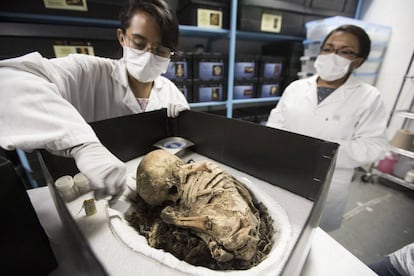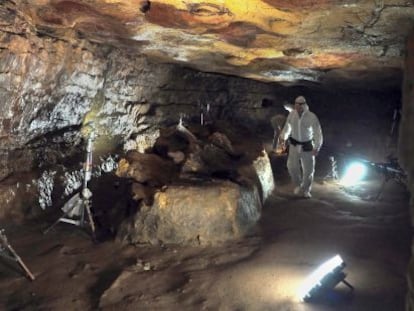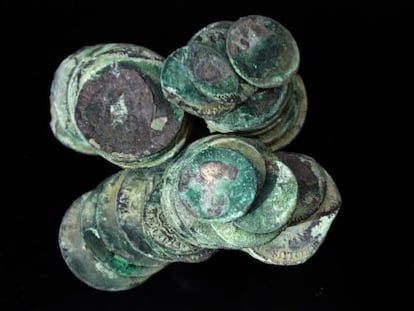Mexico City’s seldom-seen bone collection sheds light on an ancient past
Specimens from Museum of Anthropology include remains of the earliest inhabitants of the Americas


Around two million people visit Mexico City’s spectacular National Museum of Anthropology every year, but few of them know they are walking on top of a huge cemetery.
In the basement of the museum some 25,000 bones are stored in carefully labeled boxes, which form towers up to three meters in height.
This historical treasure trove contains the tibias, femurs and skulls of sacrificial victims from the altars of the ancient city of Tenochtitlán, the Aztec capital the Spanish conquerors destroyed when they built Mexico City in the 16th and 17th centuries. Also in the collection are bodies exhumed from the first cathedral of the colony of New Spain, in Veracruz, as well as human remains unearthed by archeologist at Mayan, Zapotec and Olmec sites in the south of the country.
This is one of the world’s most important collections with some of the oldest skeletons on the American continent
José Concepción Jiménez
But the collection is not just of huge historical significance.
“This is a sacred space, because there are human bodies here. We are in the presence of many people,” says José Concepción Jiménez, who has spent more than three decades cleaning, preserving and cataloguing a collection begun 130 years ago.
Jiménez is surrounded by black boxes containing the largest collection of mummies in the country. Some 30 of these are expected to go on display when the economic reins are loosened and money flows into the country’s cultural sector again.
The oldest mummies, which are some 600 years old, date back to a period before Spanish colonization. They are Tarahumara children from Mexico’s northern Chihuahua state who were found wrapped up in sleeping mats in a fetal position. Next to them were combs, beans and toys. Scientists are now carrying out genetic testing to see whether there is a direct link with modern-day Tarahumara people or if there has been a population shift in this northern part of the country.
The mummified body of another child dates from the period of Spanish colonization. Buried in the Church of Santo Domingo in Zacatecas, the baby was dressed as a saint. The child was buried alongside its family, who were originally from Spain’s Basque Country and came to Mexico to run mines. The presence of gold buttons and thread in the family tomb suggests they were relatively wealthy.

“Looking at these bodies you can also see how customs change. Here the hands and feet are tied up and they are placed in coffins with crucifixes and offerings for saints,” says Jiménez of the Basques.
The basement of the National Museum of Anthropology – Mexico’s most popular museum – is also home to 51 bodies from the pre-ceramic era, or before 2,000 BCE.
“This is one of the most important collections in the world, with some of the oldest skeletons on the American continent,” says Jiménez. On the table in front of the anthropologist are five skulls, the oldest of which belongs to the so-called Peñón woman, whose skeleton was found in 1959 just kilometers from Mexico City.
Some 30 mummies are expected to go on display in the coming months
Although she was aged between 24- and 26-years-old, the anthropologist calls her “the grandmother of the Mexicans”. Carbon dating carried out in the UK shows her skull is 12,700 years old, making her among the oldest inhabitants discovered in the Americas to date.
This is far more recent than the date for the bodies found at Sima de los Huesos in Atapuerca in Spain’s Burgos province, which are hundreds of thousands of years old.
“But we have the cradle of Mexico here,” says Jiménez. Here in the center of the country archeologists have found some of the oldest Americans, including Tlapacoya Man, who is 12,000 years old, and a 10,000-year-old man from Texcoco. Then there is the 10,500-year-old Metro Balderas Man, found during constructions works for Mexico City’s metro.
The collection has also managed to clear up a few historical controversies. Part of the archive is kept under lock and key and it is here that 300 bones displaying evidence of physical deformations and illnesses can be found. From an open box comes a bitter smell while a glance inside reveals a 1,000-year-old skull. The front section is rotten.
“The person had syphilis, which means the illness predates the arrival of the Spaniards in America,” Jiménez explains.
Gabriela Salas, an anthropologist on the team that oversees the collection, says the thousands of bones have helped to establish “the genetic history of the Mexican people”. History is there in the bones. You only have to learn to look at death up close.
English version by George Mills.
Tu suscripción se está usando en otro dispositivo
¿Quieres añadir otro usuario a tu suscripción?
Si continúas leyendo en este dispositivo, no se podrá leer en el otro.
FlechaTu suscripción se está usando en otro dispositivo y solo puedes acceder a EL PAÍS desde un dispositivo a la vez.
Si quieres compartir tu cuenta, cambia tu suscripción a la modalidad Premium, así podrás añadir otro usuario. Cada uno accederá con su propia cuenta de email, lo que os permitirá personalizar vuestra experiencia en EL PAÍS.
¿Tienes una suscripción de empresa? Accede aquí para contratar más cuentas.
En el caso de no saber quién está usando tu cuenta, te recomendamos cambiar tu contraseña aquí.
Si decides continuar compartiendo tu cuenta, este mensaje se mostrará en tu dispositivo y en el de la otra persona que está usando tu cuenta de forma indefinida, afectando a tu experiencia de lectura. Puedes consultar aquí los términos y condiciones de la suscripción digital.










































